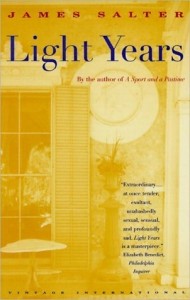 Mrs. Dalloway Meets Emma Bovary While The Sun Also Rises.
Mrs. Dalloway Meets Emma Bovary While The Sun Also Rises.
Salter, James (1975/1995). Light Years. New York: Vintage.
If you enjoy lyrical writing, fine descriptions, acutely observed personalities, this book is for you. It’s an impressionistic portrait of two main characters, Viri and his wife, Nedra, who begin the novel married, and end it unmarried. They have children, they grow older, and they die. Along the way, they don’t face any serious challenges. There are no fires, floods, political upheavals, financial collapses, terrorist attacks, car crashes, drug addictions, career achievements, promotions, adventures, or triumphs. Nobody is curious about anything, nobody attempts anything, nobody learns, nobody changes.
Instead, Viri and Nedra are aesthetes. They care about movies, theater, literature, paintings, architecture, music, country living, high-end shopping, fine wine, and gourmet cooking. And sex, which is casual and plentiful.
Perhaps “care” is too strong a word. These characters certainly consume the arts, but they don’t study or participate in them, or produce anything more than sock puppets, scrapbooks, and line drawings. They apparently have a mountain of money to support their aesthetic, sheltered, self-absorbed and idyllic lifestyle, though the source of funds is never explained. He’s a mediocre, unknown architect in New York and she’s a housewife.
In short, the characters are not interesting or believable. They face no challenges and they reveal nothing of themselves. Instead, the third-person narrator tells us what they supposedly think, believe, and feel. Love is declared, tears are displayed, but none of it is adequately motivated. The strongest motivational thread is that both characters fear ageing. At age 34, Nedra obsesses over wrinkles. Viri worries, in his fifties, that life has passed him by. This obsession with ageing makes the characters seem even more superficial. Unfortunately, I don’t think Salter was trying to make an ironic point. They really are just vacuous characters.
I characterize the book as a fine example of prose poetry, loosely wrapped in a sentimental slice-of-life story. It’s really all about the writing and the excellent observation and phenomenology. At random:
“Life is weather. Life is meals. Lunches on a blue checked cloth on which salt has spilled. The smell of tobacco. Brie, yellow apples, wood-handled knives” (p. 25).
“In the woman who overwhelms us there must be nothing familiar. Faye was telling a story about Arnaud buying an airplane; it wouldn’t fly, she said, wasn’t that typical? …Viri tried not to stare. He was helpless at gatherings like this where the conversation was rapid and cynical, the encounters remote as at a dancing class” (p. 31).
“The walls were a faded turquoise, a curious color he no longer disliked” (p. 69)
“He wore a white cap and a ribbed shirt, pants the color of tobacco or certain perfumes, and a scarf for a belt” (p. 107).
“The book was in her lap; she had read no further. The power to change one’s life comes from a paragraph, a lone remark” (p. 161).
“Is illness an accident, or is it a kind of choice, the way love is a choice – hidden, involuntary, but sure as a fingerprint?” (p 254).
Despite very enjoyable writing like this, Salter does sometimes slip into grotesquely overwritten sentimentality, a problem that arises from trying to develop characters who lack genuine interiority. Still, on balance, the writing pulled me through to the end and I’m glad to have met James Salter.
